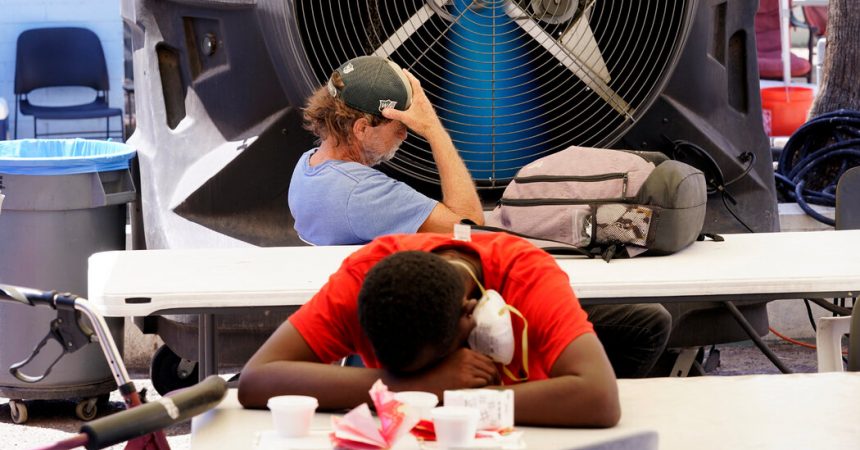Air-conditioning was long considered a luxury in much of the world. Not anymore.
Look, for example, at a move earlier this month by the Biden administration: For the first time, residents of public housing can ask the federal government to pay their air-conditioning bills during periods of extreme heat. The program, which is run by the Department of Housing and Urban Development, is optional, and it authorizes local public housing authorities to use federal funds to pay for residents’ cooling costs. It could affect the more than 1.6 million low-income residents of public housing who may now find respite in their homes from the dangerously high temperatures killing people around the world.
While the measure was seen by experts as a step in the right direction, the need is far greater. Tens of millions of Americans can’t pay their energy bills, and there is often no legal requirement for landlords or building owners to provide air-conditioning. That’s not to mention the millions of Americans who are struggling to pay rent, or who are homeless, or who die in their homes with broken air-conditioners.
As thousands fall ill or die from the heat each year, public health experts increasingly point to a sprawling set of challenges with one uniting factor: Housing is at the root of what makes people vulnerable to high temperatures.
It’s not news that the United States is mired in a housing crisis. For many, housing is less affordable than it has been in decades, and finding a way to build more and better homes has been a challenge, even in some of the wealthiest places in the country. The housing crisis and poverty have compounded, making many people powerless against the heat.
There are solutions, but enacting them won’t be cheap, said Mark Wolfe, who leads the National Energy Assistance Directors Association, a nonprofit that represents states in the federally run Low Income Home Energy Assistance Program, which provides funds to reduce the costs of energy bills.
“The rules we have in place to protect families from high temperatures were written many years ago,” he told me. “We need a new approach, a new way of thinking to help low-income families adapt to higher temperatures.”
Systemic challenges
The World Meteorological Organization has said that more people die from heat than any other extreme weather event. A lack of access to cooling indoors is one of the main factors, according to a 2023 survey of heat-related deaths in Arizona’s Maricopa County, which is home to Phoenix. Though a majority of people who died had air-conditioning, most of the units weren’t working or were unplugged.
Housing codes have long required landlords to provide tenants with heat but don’t require they provide air-conditioning. That’s only starting to change. Cities like Phoenix and Dallas now have laws that require landlords to provide air-conditioning. But often these rules are not enforced, as Marketplace reported in 2022.
Tenant rights are only a small part of this issue, Wolfe told me. Governments also need to change building codes to require more energy efficiency and to accelerate the transition to renewable energy sources, so that increased air-conditioning use doesn’t make energy bills unaffordable and doesn’t emit even more heat-trapping gases. Cooling, as we’ve reported in past newsletters, is the fastest-growing source of greenhouse gas emissions.
The Biden administration is trying to address these issues by rolling out new energy standards for public housing and other federal projects, and issuing tax credits to retrofit homes. But transforming the housing system will take a long time and enormous investment. It’s why Wolfe advocates more federal and state help for people struggling with energy bills.
“We need both a more robust system for how people will pay their bills, as well as a long-term plan to retrofit the housing stock,” he said.
But Congress has sharply reduced funding for programs to help low-income Americans pay their energy bills, and more than 20 million U.S. households are now behind, according to an estimate by the nonprofit that Wolfe leads.
The housing crisis
America’s housing crisis has significantly worsened in recent years. Home prices, already high, soared during the pandemic, rising more than 40 percent nationally from the end of 2019 to mid-2021, and have grown steadily since then. Now, about a quarter of renters spend more than half their income on housing, and homeless camps have expanded, as my colleague Conor Dougherty, who covers housing for The Times, wrote recently. That pressure has had a huge effect on people’s vulnerability to heat.
“High home prices in places like California are essentially forcing middle- and lower-income people to move to hotter, much cheaper housing markets in Arizona and Texas,” Dougherty told me.
And then there is the challenge of building more housing. It’s hard to find any factor that makes people more vulnerable to heat than homelessness, Will Humble, the executive director for the Arizona Public Health Association, told me.
In 2023, the hottest on record, heat-related deaths recorded in Maricopa County climbed 52 percent, to 645. Almost half of the people who died were homeless.
“We talk about how smoking increases the chance of you getting lung cancer by 40 percent, and that sounds like a really high amount,” Humble told me. “But being homeless increases your chance of dying from heat in Phoenix by 50,000 percent.”
Related:
3 practical ideas to beat the heat
An app that helps people find relief from the heat. A tiny insurance policy that pays working women when temperatures soar. Local laws that help outdoor workers get water and shade on sweltering days.
As dangerous heat becomes impossible to ignore, an array of practical innovations are emerging around the world to protect the people who are most vulnerable to its hazards. What’s notable is that these efforts don’t require untested technologies. Instead, they’re based on ideas that are practical and already known to work.
They offer a window into the need to adapt to the new dangers of extreme heat that have played out vividly in recent weeks, killing still untold numbers of religious pilgrims, tourists and election workers around the world and driving up emergency room visits for heat-related ailments in the U.S. — Somini Sengupta






